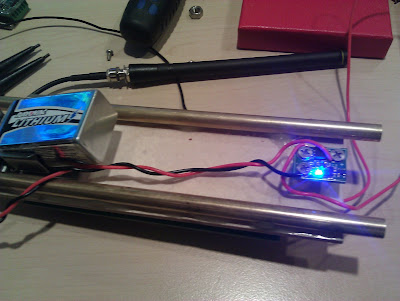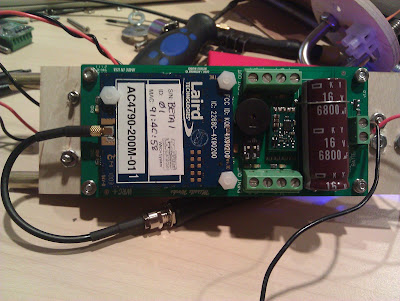- Joined
- Jan 19, 2009
- Messages
- 2,693
- Reaction score
- 308
Anyone know how would be the best way to use the featherweight magnetic switch with an arts 2 in dual battery mode?

I think the arts2 requires 7.9 volts to operate, I think the output on the switch is 3.something volts....
I have decided against it, let me know if your mileage varies.
You can use them with any altimeter, and with any battery from 3.6V to 16V.
They'll handle 20 Amps for a 1-second pulse, or 12 Amps continuously.
I think the arts2 requires 7.9 volts to operate, I think the output on the switch is 3.something volts....
I have decided against it, let me know if your mileage varies.
Really? I just got a Raven II and the same switch. That's a pretty big V drop. I can't verify the specs being there's no instructions for it. I'll test the voltage under load tomorrow. BTW, talk about small surface mount parts! Before actually receiving the units I thought I'd wire in some external led's to the AV bay... I can barely see the led's on the board with really strong reading glasses lol. Good luck soldering that. That's too bad, I really like all those blinky lights!
Troj, the arts2 has a pyro circuit and and logic circuit. they are seperate to my knowlege.
you can run the switch on any battery, but the output voltage is what matters, Adrian told me a while back what it was and I cant remember. Made me think it may have issues...
I think a better number for the arts2 was 7.74, or 7.4 and i cant remember what Eric told me there either... i have it in an email...
If you were to use the swicth with an arts 2, My opinion is that it should use the Switch Ports... Not inline with the battery, that way if it is designed to disconnect the pyro charges, and the logic circuit,, your not inadvertantly powering them by bridging these ports.!!!!!
BUT if the release says ANY altimeter,, its as Advertised... i may change my mind and get some...


I can attest to the greatness of Adrian's magnetic switches.
I've already installed two; one in a minimum diameter carbon fiber rocket, and one in an oddroc. Both would have been very difficult to install traditional switches.
The switch itself is TINY, although I am happy to report Adrian decided to make it compatible with 4-40 screws rather than the raven's 2-56 only which makes it easy to pick up mounting hardware at your local home depot, or ace hardware.
Mounting was super simple, and you don't really need instructions as the in, out and ground are all silk-screened onto the pcb.
My ONLY complaint is the first switch I installed turned out to be bad (I will be returning it soon). I didn't know it was bad because I didn't know the "normal" behavior of the switch, and it took me a while before I started swapping out parts to realize the first one wasn't working properly (turned on immediately upon putting the battery in)
Thanks, Alex!
Starting out in the "on" position when you plug the battery in is normal. Does it fail to turn off with the magnet?
Sorry, should have been clearer - switch seems to be stuck in the on position. Magnet has no effect on the switch.
Anyone know how would be the best way to use the featherweight magnetic switch with an arts 2 in dual battery mode?
in single and dual battery mode the arts2 still only uses one switch so to keep with their design just sodder your switch leads that you put into the screw terminals to the featherweight magnetic switch.
AdrianA said:You can use a magnetic switch in place of any other switch that you would put on the high side of the circuit, as long as the battery voltage is 16V or less,....
Chris, Adrain.....
Perhaps, some reasearch can be done at LDRS to see the best way to do this....
I have a dual Arts2 setup, run one of them conventionally, and one of them with different variations on the switch....
When you measured the 12 Amps, was the measured voltage simultaneous with that, and if so, where did you measure it?A couple of comments here...
First off, thank you Adrian - as usual, fantastic customer service. I'll send back the old one so you can figure out what may have happened.
Here are a few measurements I just took from my switch setup you can see in the photo above.
All testing was done using an energizer 9 volt lithium battery - if you take the battery apart, it uses three 3.2v batteries connected in series.
I used a HP 34401A bench multimeter which is pretty darn accurate.
Voltage of the energizer battery connected directly to the multimeter: 9.613
Voltage from the altimeter side of the magnetic switch after connecting the same battery: 9.610
Voltage and amperage from pyro 0 terminal when I simulated a .1 ohm load (basically shorting the battery): 9.34 volts, 12.31 amps
hope this helps someone.
When you measured the 12 Amps, was the measured voltage simultaneous with that, and if so, where did you measure it?
Thanks.
Are you coming to LDRS? We could meet up there.
Enter your email address to join: